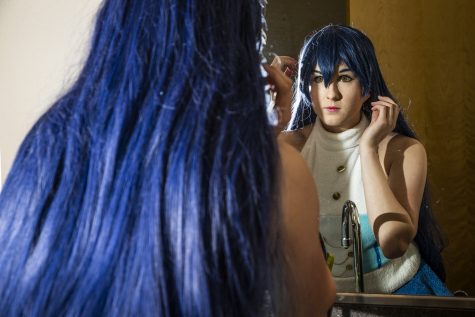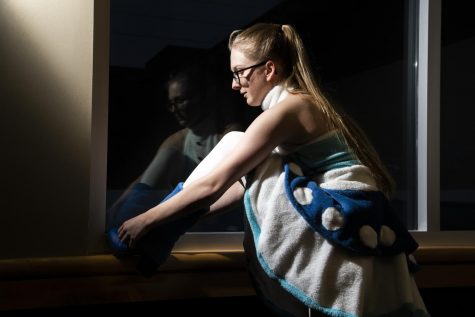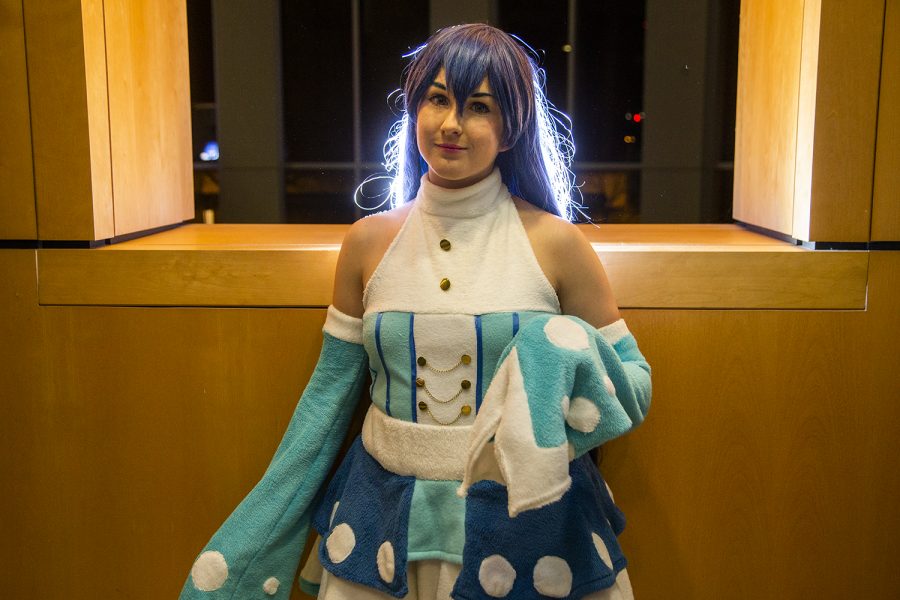Cosplay: The art of bringing fiction to life
Cosplay, or costume play, allows fans of comics, anime, manga, and other geeky content express their love for their fandom.
UI Cosplay Club President Leah Carlson poses for a photograph in the Adler Journalism Building on Monday.
It takes Leah Carlson a while to get ready. But, that’s to be expected when you’re transforming yourself.
First, she swept her long, blond hair back, first into pigtails and then into short buns. She then slid a black mesh cap over her head, tucking in each strand before placing a tan-colored cap on top. Makeup, a bright blue wig, brown prescription contacts, and a handmade costume later, Carlson was miraculously transformed into Umi Sonoda, a character from the anime Love Live.
For fans of all things video game, anime, cartoon, science fiction, and fantasy, cosplay — or costume play — is an outlet to allow a deep love of something shine through everyday life. The term cosplay, according to geeks.media, was coined in 1993 and involves people dressing up as their favorite characters in costumes that they buy or build themselves.
While cosplay can be as simple as combining everyday clothes to mimic a character they are trying to portray, they can also be incredibly intricate: delicate fabrics, thermoplastic armor, chain mail, film-grade makeup, and realistic wigs can all go into one cosplay.
According to Cure WorldCosplay, the cosplay market, though difficult to estimate, is approximately $25 billion to $50 billion. Its popularity started increasing in the 1990s and initially focused on anime and manga characters, according to Vox. It has since expanded to include characters from all facets of geek culture.
Carlson, the president of the University of Iowa Cosplay Club, has transformed herself into her favorite characters for the past five years.
“I’ve always been a huge nerd; I’ve always loved anime, manga, video games, superhero stuff, comics — and I’ve also always been a very crafty person,” she said.
Five years ago, she decided to go to her first convention, Anime Iowa in Des Moines, where fans of anime and all things geeky gather for three days in the summer to hang out, attend panels, and shop from vendors. The cost of attending conventions vary; Anime Iowa costs $45 to $55 for preregistration, not including accommodations, travel, or food. San Diego Comic Con, the international and best-known convention, costs $265 for a four-day event pass, and passes sell out rapidly.
Carlson’s first year at Anime Iowa, she cosplayed the character Shinra Kishitani from the manga and anime series Durarara, as well as the character Sasha from Attack on Titan.
“My first few weren’t great, they were kind of just cobbled together, but I had the most fun I’ve ever had,” Carlson said.
The first thing she looks for when selecting a character to cosplay is which characters and which outfit designs she likes best.
“I’ll see a character and say, ‘Oh, I really like that design,’ ” she said. “I have a list of 100 characters where I’m like, ‘I like this design, I wouldn’t mind cosplaying it at some point.’ ”
Carlson said she also selects her costumes based on skills she wants to hone, challenging herself each time in one area of the costume, be it a specific sewing technique or a difficult makeup look.

Building challenging cosplays can take some serious time; Carlson said her simple cosplays can take as little as 30 hours of work, and her more intensive ones can take more than 100 hours, such as her latest cosplay, Link’s Barbarian outfit, from the video game Legend of Zelda: Breath of the Wild. She’s building a series of weapons, including a 5-foot sword.
Carlson said she loves cosplay for both learning the practical skills and for expressing her creativity in the character she loves.
“It’s an outlet of sorts; it’s a creative outlet,” she said. “I think it’s really cool, because at the end you have this finished product, and you put it on, and it’s such a sense of accomplishment and pride.”
The UI Cosplay Club has been active on campus for the past four or five years, Carlson said, and has around 15 to 20 active members. She said her favorite meetings are on Sundays, in which members of the club will help each other build their costumes, and they work together when someone faces a challenge.
Two cosplayers who have been around the cosplay block for a while live in North Liberty, and in the upstairs of an unsuspecting home, lies a room in which cosplay creativity was meant to thrive.
Two cats bounced around 32-year-old Kara Blumenstein’s brightly lit studio, where large sewing tables held fabrics being molded into costume pieces. A wall of multicolored fabrics sat at one end of the room, with a plethora of plastics, foams, paints, and other craft equipment on shelves throughout the space. Anime posters decorated the space, as well as photos of past cosplays; in one photo, Blumenstein posed as Rosa from Final Fantasy 4 in a flowy white cape and a carefully styled white-blond wig.
Blumenstein has cosplayed since 2002, and like Carlson, she had sewn from a younger age before her introduction to cosplay. From simple fabric designs, Blumenstein has now moved on to challenging building techniques, such as resin casting, where the designer will use molds and silicones to create three-dimensional items to enhance a costume.
RELATED: Now loading: Cosplay in Iowa
She said a key change she has seen in her 17 years of cosplay is the material for cosplays, as well as its popularity in pop culture.
“I think more people are getting into it, especially now that more materials are available than there ever have been,” she said. “Back when I started, in the early 2000s, most people wouldn’t even wear wigs because the only wigs you could get were cheap party wigs that looked really, really bad.”
In 2015, she roped friend Alex Musel, 28, into cosplay, helping her craft an intricate armored Wonder Woman costume, the photo of which hangs in the studio next to Blumenstein’s.
Musel, in addition to cosplaying with Blumenstein at the seven or eight cons they attend each year, also cosplays as a part of a nonprofit called Cedar Rapids Ultimate Super Heroes that assists in charity events.
When cosplaying with the group, Musel must be fully in character, because the children she meets genuinely believe they are meeting the real Batgirl or Wonder Woman.
“I imagine what children will ask me and then think of responses,” she said. “Which are as easy as, ‘Are you real,’ and how to tell a child, ‘Well, is this a real Bat-a-rang?’ or, ‘Do you think I’m real?’ Just thinking of responses before you’re asked.”
Getting into some characters can be easier than others, Blumenstein said.

“Certain ones are a lot easier, especially if I know the character really well, it’s a lot easier to be in character,” she said. “Certain ones that match with your personality are a lot easier; Raven [from Teen Titans] is easy, because most of the time I’m just sighing at [Alex] anyway.” Laughter ensued.
Being in character helps create a fully believable, real-life version of a fictional character, all the more assisted by an intricate, realistic costume. Working with the complicated crafting materials can add up, with some costume prices ranging into the thousands of dollars.
“If you don’t want your child to do drugs, get them into cosplay, and they won’t have any money for it,” Musel said and laughed.
Cost aside, both cosplayers love both the craft and the cons, which they describe as a safe place to express their love of different fandoms and to meet new people who like the same shows, comics, and video games that they do.
“For so many people going to cons, it’s one of the only times they can let loose with who they are, because they know that everyone else there is just as ‘weird’ as they are,” Blumenstein said. “They don’t have that social awkwardness. Cons allow people to drop barriers.”
Musel agreed, saying they have allowed her to make new friends she wouldn’t have met otherwise. She also encouraged those getting into cosplay, saying now is one of the best times for newcomers to the community because of internet resources.
“Geek culture has really helped with that,” Blumenstein said. “People are really embracing what it means to be a geek and enjoying stuff that 10 years ago people would have been like, ‘Oh, what do you like that for?’ ”



